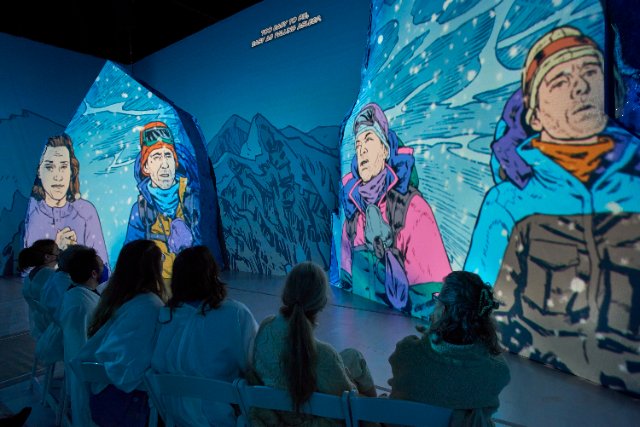Everest: An Immersive Experience (Opera)
Innovative Format for a Compelling Work from Opera Parallèle
By: Victor Cordell - Feb 07, 2023
For all of human history and eons before, Mount Everest has stood as steady as a rock – literally. In its eight years, the opera “Everest: An Immersive Experience” has had three very different realizations, even though under the baton of Nicole Paiement for each version. The genesis of the opera’s narrative is a real-life tragedy about three members on an Everest expedition in 1996, two of whom never came back.
“Everest” premiered in traditional stage form at Dallas Opera. Then, motivated by the pandemic, it transmutated under Brian Steufenbiel’s direction into an immersive, animated opera film by Opera Parallèle for home viewing. Extending the film’s structure, it now returns to performance before a live audience in an innovative form under the guidance of the same two creative artists and their company. The result is a unique and gripping 70-minute operatic experience.
Rather than a traditional live performance, the soundtrack for this production is recorded. The box-like, flat-floor theater provides scenic-surround, with motion-capture animation projections on all four walls. Having the grainy, low-resolution, slow-moving look of images from a graphic novel, its illustrations are by Mark Simmons, projection design by David Murakami, and scenic design by Jacquelyn Scott. Most of the important visuals project onto the forward sections of the venue’s wall, but scouring the full 360 degrees is certainly grounds for neck ache.
Mountaineers confront many enemies – possibilities of illness, falling, storm, avalanche, and more. One constant is the inevitability of the race against time. The climbers are reaching the summit 30 minutes after safe turnaround time. Visual portrayal of the passage of time on the screen in addition to the slow dimming of light on the projections constantly forewarns of the risks ahead and adds to the tension of the score and the visual account.
Expedition guide Rob Hall has left Beck Withers 2,000 feet below, as the latter is suffering high altitude blindness. Hall struggles to help Doug Hansen on the final assault, passionately urging him, but Hansen weakens and is unable to keep up. The portentous depiction of the repetitious entreaties and pulsing music leaves the viewer quavering. Flashbacks, reflections by the climbers, and radio communications with loved ones, both fearful and mundane, add to the anxiety sensed by the audience. In a series of “what if” circumstances, a combination of deadly factors befalls the climbing party.
Although the storyline is accompanied by simple graphics, the severity of the consequences carry inherent drama, which is amplified by the choppiness of the music and the urgency of the dialog. Joby Talbot’s eerie music for “Everest” is appealing and effective. In keeping with the geographic situation, grandness, howling, groaning, and ringing abound in the score, describing the vastness of the horizon, the wind, and obstacles to overcome.
While there are some brief soliloquies and duets, conversational mode dominates the libretto. The instrumental music backing the lyrics emphasizes percussiveness, while the sung melody lines are largely tonal. Gene Scheer’s crisp and often stressful lyrics provide tautness, especially as Hall tries to induce Hansen onward. The libretto speaks both to the grandeur and threat of the environment as well as the intimacy of the human experience. Among the many ominous and touching lyrics are “Is this how it ends?” and “How can you know when you’re starting to let go?”
The quality of the musical performances is nearly flawless, delivered by a system that produces rich, full, spatially-mapped sound. It is outstanding recorded music, but it is not comparable to live opera. The voices of Nathan Granner, Hadleigh Adams, Kevin Burdette, and Sasha Cooke are electronically enhanced and presumably re-recorded until everything is just right. The chorus that represents the soul of the mountain sounds like 40 voices, but is four singers who are repeatedly overtaped. Rather than a traditional orchestra, the orchestral sound comes from MIDI (musical instrument digital interface).
The great appeal of this unusual entertainment raises a couple of broader questions. First is whether immersive, electronic opera represents a form that surpasses novelty to become a significant niche, a Cirque de Soleil of opera. Perhaps some other productions will follow “Everest,” but the answer to the question is probably not. To be sustainable as a form requires an audience with interests at the intersection of immersive electronic performance and opera music.
Among its many attractions, live opera is compelling because of the thrill of hearing highly accomplished vocalists and instrumentalists operating without aids. Another aspect is the sheer humanity of the living form on stage interacting with the audience, from the crowd’s gaiety in the Café Momus scene of “La Boheme” to the intimate death scene sequence in “Otello.” Electronic entertainment certainly has its benefits, but the market for live opera will remain.
The psycho-social issue is why mountaineers risk death for exhilaration. Is it to accomplish or to escape? To conquer? To stroke one’s ego? Rob Hall notes that “This is where I want to be.” It’s the only place that he can find bliss, but what does that say about the rest of his life? And in seeking that bliss, he endangers the future of his pregnant wife and children. It may be the ultimate price to pay.
“Everest,” an opera composed by Joby Talbot with libretto by Gene Scheer, is produced by Opera Parallèle and plays at Z Space, 450 Florida Street, San Francisco, CA through February 12, 2023.




